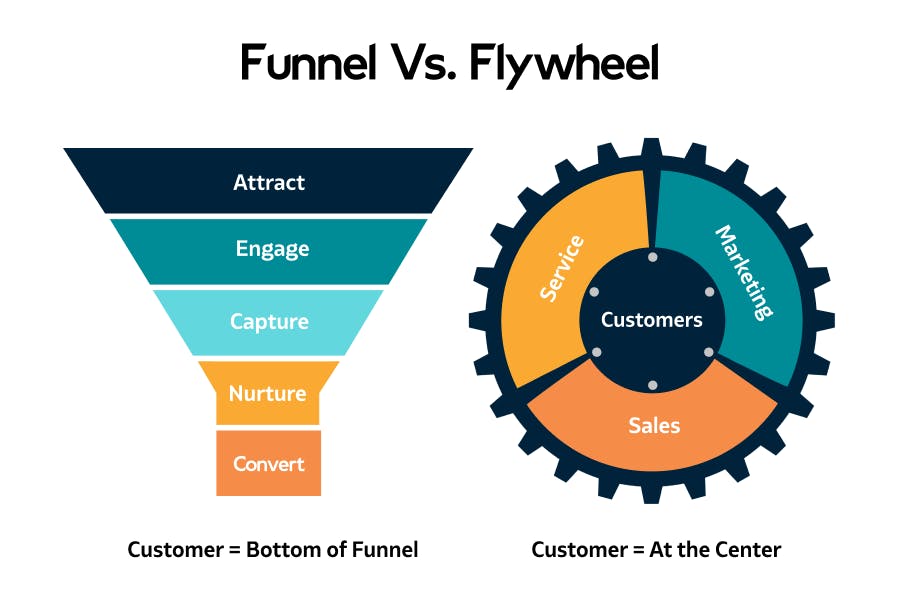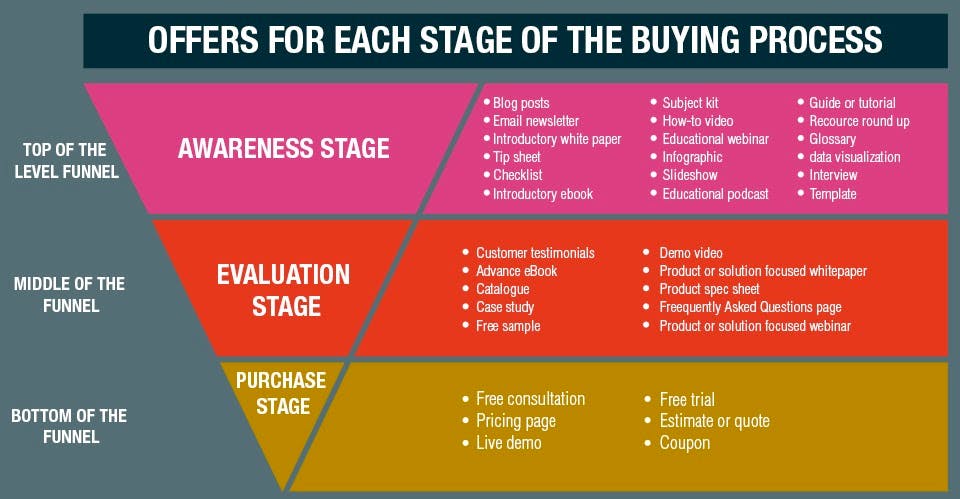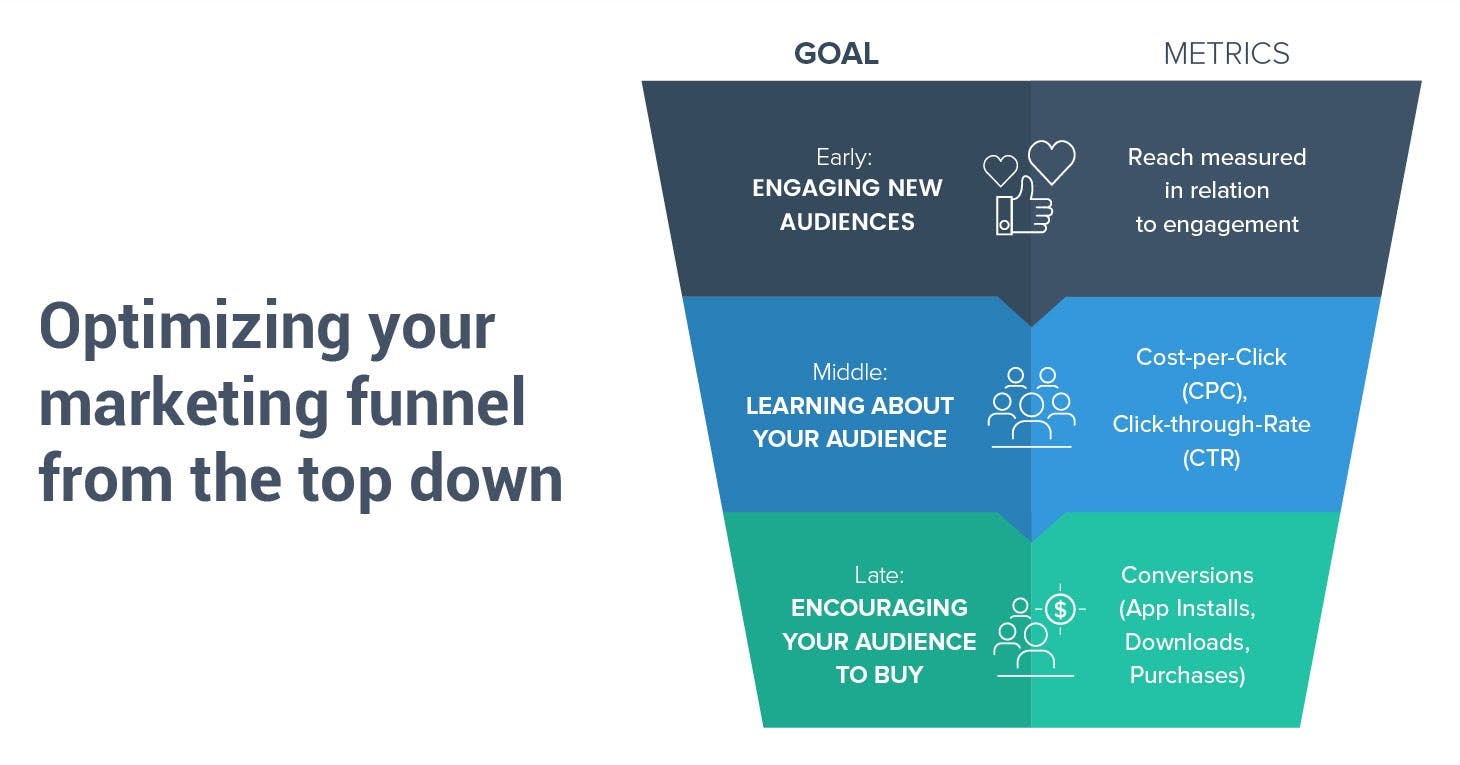Conversion funnel: top, middle, and bottom of the funnel content
Jan 5th, 2022

Contents
What is a conversion funnel?
Stages of the conversion funnel
How to optimize the conversion funnel
Growth after conversion
The concept of the conversion funnel is a perfect model for visualizing the customer journey starting from awareness and ending with purchase. One of the major reasons to create a conversion funnel is the opportunity to generate more qualified leads. However, building a powerful conversion funnel has many advantages, including improved communication with customers, higher conversion rates, and more accurate sales volume forecasting.
The conversion funnel is crucial for your business as it allows targeting your marketing efforts at various customer segments. At each stage, customers will receive different messages that provide them with relevant information and recommendations to make the buying decision. Furthermore, a conversion funnel will help your company significantly increase the rate of recurring customers, which in turn will lead to business growth.
What is a conversion funnel?
Conversion funnel is a term used in e-commerce or SaaS marketing to describe a customer journey starting from awareness for a product or service and leading to the purchase or conversion event. The word “funnel” is used to illustrate that consumers have limited choices at each step while purchasing the product or service. In digital marketing, a conversion funnel is a model aimed at customer acquisition, retention, and increase in the customer base by utilizing technology and other resources to better fulfill consumer needs.
The conversion funnel represents the customer journey and lays out the steps the potential customer should take to perform a specific action or series of actions. The model helps businesses engage leads, address issues, and respond to questions concerning the company. In addition, it allows marketers to divide the potential customers into categories and develop points of contact and suitable content plan, ensuring that customers are satisfied with the business.
There are two main types of conversion funnels - the traditional model and the flywheel model. The classic marketing funnel is linear. It implies that prospects enter the funnel at the awareness stage, then pass through the consideration stage and finally move to the decision stage where they buy a product. However, the traditional model does not take into account the changes that happened with the buying process in the digital age. Nowadays, the customer can enter the funnel at any stage of the sales cycle. Moreover, the classic marketing funnel treats consumers as one-time buyers. It is based on the idea that interaction with the customer is over after the purchase.

In contrast to the classic conversion funnel, the flywheel model views the customers as the potential brand advocates who can recommend the products to family and friends. According to the flywheel strategy, the customers can learn about the product or service from social media or other sources without speaking to the sales representative. The concept focuses on the leads, prospects, and customers as the driving force of the flywheel or the main target of the marketing efforts. The idea is to deliver a great customer experience at every phase of the buying cycle and after the purchase. As a result, customers will be more likely to share their experiences with others, and you will be able to increase brand awareness and drive more sales with the help of your existing customers serving as brand advocates.
Stages of the conversion funnel
The concept of the conversion funnel originates from the AIDA model, which was developed in 1898 by American advertising pioneer E. St. Elmo Lewis. The model is widely used in advertising and sales processes and consists of the following steps: attention, interest, desire, and action.

According to the model, at the awareness stage, the consumer learns information about the product or brand through advertising. Then, at the interest stage, the prospect discovers the benefits of the brand and expresses interest in the specific product. Next, the potential customer creates a positive attitude towards the brand at the desire stage. Finally, at the action stage, the consumer decides whether or not to buy the product and makes a purchase or continues to search for the product that would meet the requirements.
In 1924 William W. Townsend combined the AIDA model with the funnel concept. Marketing specialists have adapted the early model to the needs of the modern customers and called it “purchase funnel” or “buying funnel”. However, there is no single universal model of the conversion funnel accepted by marketing experts, so we will describe three principal stages, including the top, middle, and bottom of the funnel.
Top of the funnel
At the top of the funnel or the awareness stage, a potential customer is experiencing a problem. They search for the information that will help better understand, formulate, and solve the problem. At this stage, the consumers discover the brand and engage with it for the first time.
The main goals of this stage are to acquire new leads and generate awareness. As the leads have little knowledge about the brand, marketers should demonstrate its value at this point. Thus, the company needs to provide the content and marketing resources that introduce the brand and its products or services to potential customers. Top of the funnel content usually includes blog articles, social media posts, videos, and infographics aimed at attracting the target audience’s attention.
Top-of-the-funnel content should not focus on selling but instead inform the leads on the topics related to your company, taking into account their interests. You need to convince potential customers that your brand is a thought leader in your industry by providing engaging, easily consumable, and valuable content. You can collect emails and phone numbers to nurture leads and include a call to action in the blog articles and social media posts to encourage clients to visit the product landing page.
Middle of the funnel
Once the customers subscribe to your emails, become your followers on social media, or interact with your brand in some other meaningful way, they enter the middle of the funnel. It is time to earn the customers’ trust and demonstrate the advantages of your product.
At the consideration stage, people identify the problem, so you need to focus on creating a dialogue with the prospects by providing valuable, reliable, and informative content that answers their questions. For example, some people have a specific list of requirements for the product, but most often, the potential customers have a vague idea of the desired solution. Thus, the marketers can use this opportunity to influence their choice as the prospects have not formed any opinion yet.
Middle-of-the-funnel content typically includes case studies and customer testimonials, video tutorials, white papers, webinars, and e-books. The company’s goals are to nurture leads and understand if a potential customer is willing to buy a product. You need to determine which leads are ready to convert and how you can achieve this. By researching popular content types, topics, and most visited pages, you can identify the prospects’ needs and create educational and persuasive content.

Bottom of the funnel
At the last stage of the funnel, potential customers make a purchase decision. The goal of this stage is to convert leads into customers. At the bottom of the funnel, people are highly motivated and ready to make a choice. They have already gathered information about your company and visited your website several times. Now, as part of your differentiation strategy, your task is to persuade them to choose your brand over competitors by providing specific reasons.
Sales teams often use bottom-of-the-funnel content. It includes webinars, e-books, case studies, free courses, use cases, and other educational resources. The most crucial component of the bottom-funnel content is a call to action. At previous stages, CTA was targeted on lead generation and nurturing, but at the bottom of the funnel, it should encourage prospects to take one specific action: buy a product.
To stand out from competitors, you need to analyze their bottom-of-the-funnel content and demonstrate why your solution is better for your target audience. For example, you can describe how your product has worked with other customers and explain that your solution can address more than one problem by mentioning your company’s mission. The persuasion tactics also include emotive language that appeals to the potential customers’ feelings, success stories about your business, and information that portrays your company as a credible authority.
How to optimize the conversion funnel
The best way to optimize your conversion funnel is to break the process down into small steps according to the funnel stages. Each stage requires a unique approach, so we will apply different tactics for the upper, middle, and lower parts of the funnel.
Top-of the-funnel optimization
Top-of-the-funnel optimization aims to attract leads to your website by providing a solution or focusing on pain points. First, we will consider the landing page.
Analyze your landing pages. The first point of contact with your brand for new visitors is your landing page. You need to make sure that your web pages provide sufficient information about the products or services to convince potential customers to make a purchase. You can also run a comprehensive website audit to see how you can improve the overall user experience and search acquisition opportunities. Check your headlines and articles to understand which ones attract and engage more website visitors. Test various colors, backgrounds, and fonts to see how they affect conversion.
Measure how many people you attract every day, week, and month. Analyze the most effective marketing channels to better understand your target audience and their preferred platforms. Next, consider how many visitors continue to the following stage of the conversion funnel. Use Google Analytics and behavior reports to track pages-per-session, bounce rate, average session duration, and other website analytics metrics.
Offer free interactive content. The purpose of your landing page is to evoke consumers’ interest and motivate them to buy the products. The potential customers will search for information and products that add value, so you need to focus on unique keyword-optimized content that resonates with your audience. Addressing customers’ problems is no longer effective. Consumers are interested in brands that share their values and way of life.
Collaborate with sales and customer success teams to gain insights that will be useful in content creation. Based on the information gathered, create the set of metrics that you will utilize for different content types and funnel stages. Then prepare a content calendar taking into account your findings.
Survey visitors to see how they perceive your website. By collecting feedback from your leads, you can understand which of the tactics in your marketing mix perform well at the awareness stage. Use quantitative data collected from Google Analytics and qualitative information gathered through interviews and questionnaires to learn about your potential customers’ experiences.
e.l.f. Cosmetics has utilized the survey to discover the customers’ pain points, collect valuable data about the target audience, and educate customers about the brand and its products. With the help of the quiz, the company gathers information about the customers’ age, necessary skincare products, and problems. Then, depending on the answers, the brand recommends specific solutions.

Middle-of-the-funnel optimization
Now you need to earn the potential customers’ trust, answer their questions and convince them that your brand is the right choice. At this stage, people often compare brands to find the best fit for their specific requirements. The most vital elements of this stage are user experience and website content.
Optimize your website UX. In the middle of the funnel, people will visit your social media pages, browse your website for more information and read product descriptions. Make sure that your website navigation is seamless and intuitive. Get rid of the website bugs, fix the slow-loading pages, and check whether product categories reflect user intent. Add CTA buttons and provide the essential product details, such as costs, fees, and shipping.
Use heatmaps to collect information on how users navigate and read pages. For example, you can utilize the heatmaps to understand whether website visitors notice “free delivery” or “buy now” areas. Besides, scroll maps and click maps will help you monitor the users’ distractions and reasons the visitors lose interest in your website.
Use content to showcase your products. Informative and engaging content is a must at this stage. Offer explainer videos, buyers’ guides, how-tos, and case studies to educate customers and keep their attention until they make a purchase. Infographics and checklists will encourage people to share your content and increase awareness about the brand. Build a community by publishing articles on social media platforms. Use email newsletters to notify the audience about the updates.
Since the beginning of the pandemic, Slack adapted the content strategy to the new conditions. The company began publishing articles, interviews, and guides, such as “Work smarter, from anywhere: How IT leaders are shaping the new normal” or “Adapting to our new remote-work reality” to help people cope with new challenges during the COVID-19 outbreak.
Build your reputation with social proof. You can demonstrate that your products deserve customers’ attention and investments by adding testimonials, customer reviews, and comments on your website and social media platforms. Turn the most loyal customers into your brand ambassadors. Encourage influencers to tell their audience about your product or service. Share milestones when you reach a certain number of customers or app downloads.
Shopify publishes case studies and customer success stories in their blog to inspire the audience and showcase the advantages of the products. The success stories also help improve the brand’s reputation, build awareness and demonstrate the opportunities offered by the platform.
Bottom-of-the-funnel optimization
The bottom-of-the funnel is a stage where leads convert into customers. You have already built a connection with customers, but people may need reassurance that they will make the right choice. Now we will consider how to encourage prospects to make a purchase.
Offer benefits and sales. At this point, your goal is to make your product desirable. Provide percentage discounts, free shipping, or promotions related to the customers’ wishlist items. It will create a sense of urgency, and people cannot refuse the offer. Use personalized recommendations based on the products chosen by customers.
Many companies offer cashback promotions to motivate consumers to purchase more products. The customers like the idea of paying less and then getting some money in return for buying other desired products. For example, American Express gives 10% cashback on all purchases made with the card during the first four months of use.
Use abandoned cart emails. Abandoned cart emails are the marketing tactics that allow your company to bring back lost sales. These emails are sent to users who added an item to the cart but have not completed the purchase. It is a very effective retention strategy that can help increase sales by 3%–14%.
Dollar Shave Club sends the abandoned cart emails containing the question “Where did you go?” in the subject line. In the email, the brand describes the advantages of Dollar Shave Club products and services and provides a 100% money-back guarantee to eliminate customers’ doubts.
Analyze conversion metrics. It is critical to measure your marketing effectiveness to identify areas for improvement. The metrics to be considered include earnings per lead, total purchases, return on investment, demo requests, and trial signups. If cart abandonment and cost per lead metrics are going down, you are doing everything right.
Growth after conversion
Once the customer has made a purchase, you have the opportunity to build a sound relationship and turn them into brand advocates. Here are some tips.
Build a strong social media community. Encourage customers to follow your social media pages and share your posts. Provide relevant and valuable content. Focus on creating shareable articles, videos, infographics, and other content types that solve customers’ problems and enhance your product marketing efforts.
Provide customer loyalty programs. Offer upsell and cross-sell opportunities depending on the customers’ purchase history. Create referral programs to motivate people to promote your products.
Keep users engaged by sending relevant offers. Add the most loyal customers to your email list and send them updates and publications related to their favorite products.
To optimize your conversion funnel, you need to examine it from the customer’s point of view. Collect users’ feedback and use the combination of quantitative and qualitative data to understand the visitor's experience, what they enjoy about your website and how they decide to convert from lead to customer.
